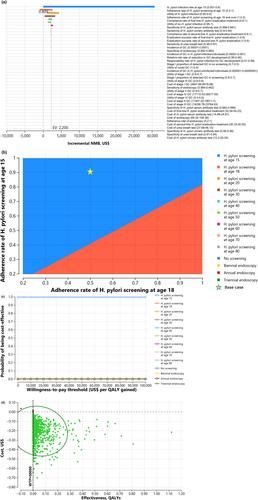Cost-Effectiveness of Population-Based Helicobacter pylori Screening With Eradication for Optimal Age of Implementation
Abstract
Background
Helicobacter pylori screening with eradication reduces gastric cancer (GC) development. However, it was unknown at what age the H. pylori screening should be implemented to achieve the greatest benefits at the least cost. This study aimed to determine the optimal age of H. pylori screening for primary GC prevention.
Materials and Methods
A state transition model for a hypothetical cohort of 15-year-olds from a healthcare payer perspective on a lifetime horizon was developed. Nine ages for H. pylori testing were considered: 15, 18, 20, 30, 40, 50, 60, 70, and 80 years. H. pylori screening was compared with no screening and annual, biennial, and triennial endoscopies starting at age 50. The main outcomes were costs, quality-adjusted life-years (QALYs), life expectancy life-years (LYs), incremental cost-effectiveness ratios, GC cases, stage I GC cases, and GC-related deaths. One-way, two-way, and probabilistic sensitivity analyses were performed to assess the uncertainty of the parameters.
Results
All H. pylori screenings at ages 15–80 were more cost-effective than all endoscopies and no screening. H. pylori screening at age 15 yielded the greatest cost-saving and benefits. The cost-effectiveness was sensitive to the adherence rate of H. pylori screening at age 15. Cost-effectiveness acceptability curves showed that H. pylori screening at age 15 was 99.6% cost-effective at a willingness-to-pay threshold of US$50,000 per QALY gained. Compared with no screening and biennial endoscopy in 15.6 million 15-year-olds from 2022 to 2037, respectively, H. pylori screening at age 15 saves US$9.70 million and US$2.39 billion, increases 1.26 million QALYs with 1312 LYs and 651 LYs, prevents 436 GC cases with 254 stage I GC cases and 305 stage I GC cases, and avoids 176 GC-related deaths and 72 GC-related deaths.
Conclusions
The optimal age for population-based H. pylori screening at ages 15–80 is the youngest, 15 years old. Shifting population-based H. pylori screening to younger people will reduce GC morbidity and mortality worldwide, along with a detailed investigation of the feasibility and long-term consequences of H. pylori eradication at a young age.


 求助内容:
求助内容: 应助结果提醒方式:
应助结果提醒方式:


